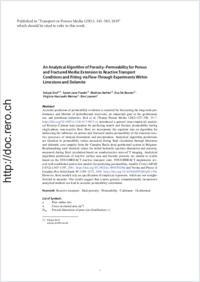An analytical algorithm of porosity–permeability for porous and fractured media: extension to reactive transport conditions and fitting via flow-through experiments within limestone and dolomite
- Erol, Selçuk Flemish Institute for Technological Research (VITO)MolBelgium - Department of Earth and Environmental Sciences, LeuvenHeverlee, Belgium
- Fowler, Sarah Jane School of Earth SciencesUniversity of BristolBristol, UK
- Nehler, Mathias International Geothermal Centre Bochum, Germany
- Boever, Eva De Department of Geosciences – GeologyUniversity of Fribourg, Switzerland
- Harcouët-Menou, Virginie Flemish Institute for Technological Research (VITO)MolBelgium
- Laenen, Ben Flemish Institute for Technological Research (VITO)MolBelgium
-
2019
Published in:
- Transport in Porous Media. - 2019, vol. 129, no. 1, p. 343–383
English
Accurate prediction of permeability evolution is essential for forecasting the long-term performance and lifetime of hydrothermal reservoirs, an important goal in the geothermal, ore, and petroleum industries. Erol et al. (Transp Porous Media 120(2):327–358, 2017. https://doi.org/10.1007/s11242-017-0923-z) introduced a general (non-empirical) analytical Kozeny–Carman type equation for predicting matrix and fracture permeability during single-phase, non-reactive flow. Here we incorporate the equation into an algorithm for addressing the influence on porous and fractured media permeability of the transient reactive processes of mineral dissolution and precipitation. Analytical algorithm predictions are identical to permeability values measured during fluid circulation through limestone and dolomite core samples from the Campine Basin deep geothermal system in Belgium. Benchmarking used identical values for initial hydraulic aperture dimension and porosity, measured during fluid circulation based on nondestructive micro-CT imaging. Analytical algorithm predictions of reactive surface area and fracture porosity are similar to results based on the TOUGHREACT reactive transport code. TOUGHREACT implements several well- established power-law models for predicting permeability, notably Civan (AIChE J 47(2):1167–1197, 2001. https://doi.org/10.1002/aic.690470206) and Verma and Pruess (J Geophys Res Solid Earth 93:1159–1173, 1988. https://doi.org/10.1029/jb093ib02p01159). However, these models rely on specification of empirical exponents, which are not straightforward to measure. Our results suggest that a more general, computationally inexpensive analytical method can lead to accurate permeability calculation.
- Faculty
- Faculté des sciences et de médecine
- Department
- Département de Géosciences
- Language
-
- English
- Classification
- Geology
- License
- License undefined
- Identifiers
-
- RERO DOC 326967
- DOI 10.1007/s11242-019-01293-z
- Persistent URL
- https://folia.unifr.ch/unifr/documents/308096
Statistics
Document views: 72
File downloads:
- boe_aap.pdf: 213
